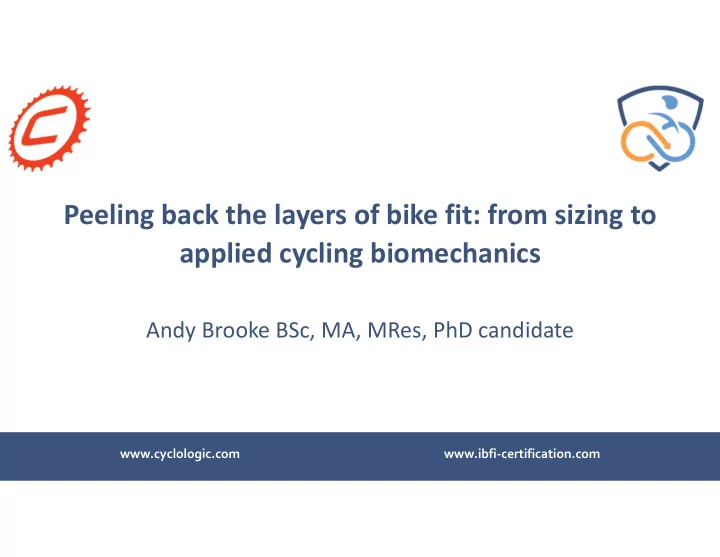

Peeling back the layers of bike fit: from sizing to applied cycling biomechanics Andy Brooke BSc, MA, MRes, PhD candidate www.cyclologic.com www.ibfi ‐ certification.com
EDUCATION Commercial interests and affiliations www.cyclologic.com www.ibfi ‐ certification.com
Introduction • Bike fitting since 2010 • MRes in Sport and Exercise Science in 2012 • International Bike Fitting Institute started in 2014 • PhD in Cycling Biomechanics started in 2015 • Associate university lecturer 2019 • 16 bike fitting courses • 10 bike fitting conferences www.cyclologic.com www.ibfi ‐ certification.com
Content • Bike sizing vs bike fitting • Basics of bike fitting • Advanced fitting and cycling analysis • The body or the bike • Future research www.cyclologic.com www.ibfi ‐ certification.com
Bike Sizing vs Bike Fitting Bike sizing Bike fitting • identifies the right size of frame • identifies the right riding position • Ball park position • Exact position • bike fits, or it doesn’t • Often requires swapping parts • Can be formulaic • Should be individualised www.cyclologic.com www.ibfi ‐ certification.com
Basics of fit – do no harm! • Cleat position Midfoot • Road neutral Forefoot • Neutral rotation/float • Saddle height • Not too low (potential knee issues) • Not too high (potential saddle discomfort) • Bar position • Too much reach can cause numb hands, Hindfoot neck/back issues • Too little reach can load saddle, create toppling, difficulty tucking out of the wind www.cyclologic.com www.ibfi ‐ certification.com
Basics of fit – continued Midfoot Forefoot Recommended ranges (training wheels) • Ranges that work for 95% of people… • 8 variables (platarflexion, dorsiflexion, knee extension, knee flexion, hip extension, hip flexion, back angle, shoulder angle) Hindfoot • (0.95x0.95x0.95x0.95x0.95x0.95x0.95x0.95=0.66) www.cyclologic.com www.ibfi ‐ certification.com
From basic to advanced ‐ critical reasoning • Conceptualise • Analyse • Question • Evaluate www.cyclologic.com www.ibfi ‐ certification.com
Chain of evidence • Interview • Physical assessment • On ‐ bike assessment www.cyclologic.com www.ibfi ‐ certification.com
Supporting evidence 3 – On ‐ bike 1 – pre ‐ fit 2 ‐ PA Knee pain • No other sport/exercise or off ‐ • the ‐ bike work Visually less ‐ developed gluteal • muscles www.cyclologic.com www.ibfi ‐ certification.com
Hypothesizing • Form a hypothesis based on the information available • Test the hypotheses • Bike interventions aren’t permanent! • Trial and error • Reassess and change if necessary www.cyclologic.com www.ibfi ‐ certification.com
The body or the bike? a) Bike only b) Body only c) Bike then body d) Body then bike www.cyclologic.com www.ibfi ‐ certification.com
Bike fit layers – ankling 1 • Basic – toe up/toe down • Absolute position www.cyclologic.com www.ibfi ‐ certification.com
Bike fit layers – ankling 2 • Plantarflexion/dorsiflexion • Terminology • Direction of movement • Ankle as absorber of force when shifting towards DF under load www.cyclologic.com www.ibfi ‐ certification.com
Recommend
More recommend